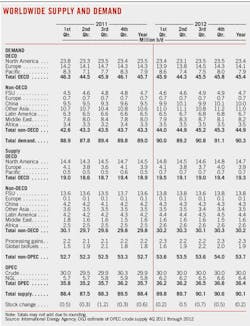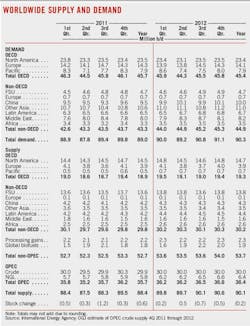US energy demand to stay weak in 2012 amid strong oil, gas production
Marilyn Radler
Senior Editor-Economics
Laura Bell
Statistics Editor
US energy demand and economic activity in 2012 will gain some momentum from last year's doldrums, but growth for each will remain anemic.
Total energy demand will increase by 1.2% in the US, according to Oil & Gas Journal's annual Forecast & Review. Early estimates indicate that in 2011, demand climbed by a mere 0.3%.
But uncertainties abound this year—from the state of the European Union and its economies weakened by debt defaults to the effects of the West's reactions to Iran's development of nuclear capabilities—and it's those uncertainties that will drive the 2012 oil market.
Downside economic risks prevail, including China's slowing growth and Europe's troubles spreading to the US. These weaknesses threaten to lower oil demand beyond current expectations.
Strong oil prices and improvements in technology will result in an increase in efficiency again in 2012, although prices should ease from 2011. The average US wellhead price for crude oil last year was $93.75/bbl, OGJ estimates. This compares with an average in 2010 of $74.71/bbl.
US oil production will rise, and oil imports will decrease again this year. US refiners, primarily those on the Gulf Coast, will gain access to more domestic crude with the reversal of some key pipelines.
Natural gas demand in the US is set to increase this year with an abundance of supply and low prices, while the use of coal for electric power generation will decline. US demand for nuclear energy and renewable energy sources will climb from a year ago, although the use of hydroelectric power generation will ease from last year's surge.
Worldwide oil demand
Ambiguity about the 2012 global economy looms as the Euro-zone is under pressure amid sovereign debt problems. Borrowing among industrialized nations reached $10 trillion last year and threatens to climb higher this year, according to the Organization for Economic Cooperation and Development.
The International Monetary Fund's (IMF) latest World Economic Outlook, published in September 2011 and entitled "Slowing Growth, Rising Risks," puts 2012 worldwide economic growth at about 4%, the same rate as last year's, but down from the 2010 growth rate of 5.1%.
Among advanced economies, economic growth will average just 1.9% this year, according to projections. IMF expects China's growth to decelerate to 9% this year from 9.5% last year and 10.3% in 2010, while in India growth is forecast at 7.5%, also down from the previous 2 years.
Displaying 1/7 Page1, 2, 3, 4,5, 6, 7Next>
View Article as Single page


